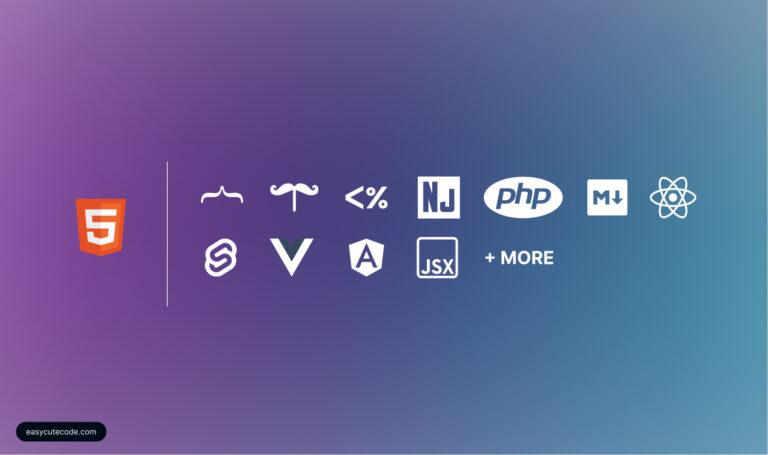
Developer Experience:
It all boils down to developer experience. The following are some reasons why a good developer experience will keep you sane.
Updating multiple HTML pages
A website with multiple HTML pages most likely uses the same HTML code for repetitive sections like the navigation bar. If you visit any website, you will notice that the ‘navigation bar’ is the same on all pages.
(learn more about naming in HTML, and you will learn what a navigation bar is and more)
When creating the portfolio mentioned above, here is the link to the series, you quickly learnt that updating the same HTML on multiple pages is a pain, and that was just 5 HTML pages.
Vanilla HTML is primarily a static markup language, limited in its ability to provide interactive and dynamic user experiences.
To create engaging web applications, developers need to incorporate JavaScript and front-end frameworks to handle user interactions, form validations, and real-time updates, ensuring a more pleasant and immersive user experience.
- Efficient Styling and Layout Control: While HTML allows for some basic styling, it lacks the robustness and flexibility provided by CSS. Cascading Style Sheets enable developers to efficiently control the visual appearance and layout of web pages, ensuring consistent branding and responsive designs across various devices.
- Code Reusability and Maintainability: Modern web development often involves working with complex codebases. Front-end frameworks, like React or Angular, promote modularization and component-based architecture, allowing developers to reuse code, enhance maintainability, and streamline the development process.
- Performance Optimization: Vanilla HTML pages might not be optimized for high performance, especially in data-heavy web applications. By utilizing front-end frameworks and optimizing server-side technologies, developers can reduce page load times and enhance overall performance, providing a better user experience.
- Cross-Browser Compatibility: Vanilla HTML alone may not handle cross-browser compatibility issues efficiently. CSS and JavaScript are essential for handling browser-specific quirks and ensuring a consistent experience across different web browsers.
- Server-Side Rendering and Data Handling: In more complex web applications, developers often need to interact with databases and handle server-side rendering. This requires the use of back-end technologies and server-side programming, which work in conjunction with HTML and front-end frameworks to deliver dynamic content and personalized experiences.
- Responsive Web Design: With the vast array of devices used to access the internet, responsive web design has become a necessity. HTML is a foundation for building responsive layouts, but responsive design relies heavily on CSS media queries and JavaScript for adaptive content delivery and optimized user experiences.
- Web Accessibility: Developing accessible websites is essential to ensure inclusivity and compliance with accessibility standards. HTML alone might not cover all accessibility requirements. Developers need to use ARIA (Accessible Rich Internet Applications) attributes and other techniques in combination with HTML to create accessible web content.
- Version Control and Collaboration: Working on projects with multiple developers requires version control and collaboration tools. Front-end frameworks and libraries, along with their associated build tools, facilitate efficient version control and collaborative development workflows.
- Community and Ecosystem: Front-end frameworks and libraries have vibrant communities, extensive documentation, and third-party packages that make development faster and more efficient. Relying solely on vanilla HTML might isolate developers from the wealth of resources and best practices available in the broader web development ecosystem.
- The Dynamic Web Ecosystem
In the early days of the web, static HTML pages were sufficient for displaying information. But with the rapid advancements in technology, user expectations have evolved significantly. Today, users demand interactive and dynamic web applications that respond to their inputs and provide seamless experiences.
- Enhancing Interactivity with JavaScript
While HTML and CSS are powerful tools for creating static web pages, they lack the ability to handle user interactions and dynamic content updates. Enter JavaScript, the language of interactivity. JavaScript allows developers to bring life to web pages, enabling real-time user interactions, form validation, and dynamic content loading without the need for page reloads. This triumvirate of HTML, CSS, and JavaScript forms the foundation of modern web development.
- Front-End Frameworks and Libraries
As web applications grow in complexity, managing large codebases becomes challenging. Front-end frameworks like React, Angular, and Vue.js offer reusable components and simplified state management, streamlining the development process and enhancing maintainability. These frameworks are widely adopted in production environments, allowing developers to build feature-rich and high-performance web applications.
- Server-Side Technologies
Web development doesn’t stop with front-end technologies. To handle user data, authentication, and other server-related tasks, developers need back-end technologies. Popular choices include Node.js, Python’s Django, Ruby on Rails, and many others. These technologies work hand-in-hand with HTML and front-end frameworks to deliver comprehensive, end-to-end web solutions.
- Responsive Web Design
In today’s multi-device landscape, ensuring that websites look great and function flawlessly across smartphones, tablets, and desktops is paramount. Responsive web design, made possible by HTML, CSS, and JavaScript, allows developers to create fluid and adaptable layouts that adjust based on the user’s screen size and orientation.
Conclusion
While HTML is undeniably the foundation of web development, the real-world web development landscape has evolved into a dynamic ecosystem that extends well beyond vanilla HTML. By combining HTML with CSS, JavaScript, front-end frameworks, and server-side technologies, developers can build powerful and engaging web applications that meet the demands of modern users. Embrace the vast array of tools at your disposal, and embark on your journey to craft web experiences that leave a lasting impact on your users.
